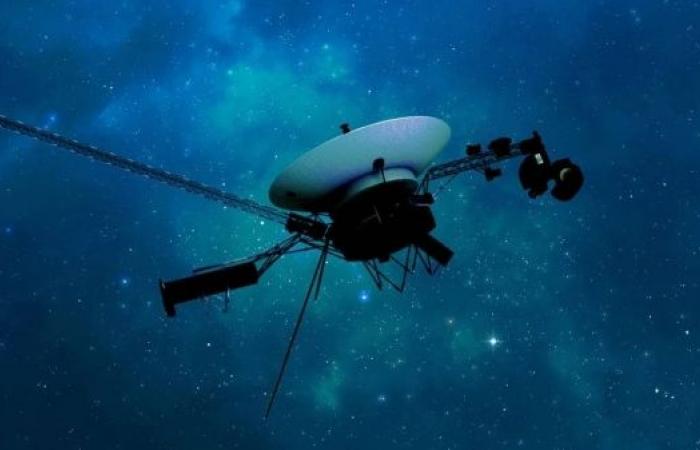We show you our most important and recent visitors news details Voyager 1 sends back science data from more than 15 billion miles away after NASA fix in the following article
Hind Al Soulia - Riyadh - WASHINGTON — The Voyager 1 spacecraft is sending back a steady stream of scientific data from uncharted territory for the first time since a computer glitch sidelined the historic NASA mission seven months ago.
Currently the farthest spacecraft from Earth, Voyager 1 stopped communicating coherently with mission control in November 2023. The probe seemed caught up in a “Groundhog Day” scenario, with its flight data system’s telemetry modulation unit sending back an indecipherable repeating pattern of code from billions of miles away.
A creative fix by the Voyager mission team restored communication with the spacecraft, and engineering data began streaming back to mission control in April, informing the team of the spacecraft’s health and operational status.
However, data from Voyager 1’s four science instruments, which study plasma waves, magnetic fields and particles, remained elusive. This information is important to show scientists how particles and magnetic fields change as the probe flies farther away.
On May 19, the Voyager team sent a command to the spacecraft to start returning science data. Two of the instruments responded, but getting data back from the other two took time, and the instruments required recalibration. Now, all four instruments are beaming back usable science data, according to an update shared by NASA on June 13.
Voyager 1’s flight data system is responsible for collecting information from the spacecraft’s science instruments and bundling it with engineering data that reflects the probe’s health status. Mission control on Earth, located at NASA’s Jet Propulsion Laboratory (JPL) in Pasadena, California, receives that data in binary code, or a series of ones and zeroes.
It took time and some out-of-the-box thinking for Voyager mission specialists to decode the spacecraft’s garbled code. But once they did, they determined the cause of the issue: 3% of the flight data system’s memory was corrupted.
A single chip responsible for storing part of the system’s memory, including some of the computer’s software code, isn’t working properly and the loss of the code on the chip caused Voyager 1’s science and engineering data to be unusable.
Since there is no way to repair the chip, the team stored the affected code from the chip elsewhere in the system’s memory. They couldn’t pinpoint a location large enough to hold all the code, so they divided it into sections and stored it in different spots within the flight data system.
There are still minor fixes needed to manage the effects of the initial issue.
“Among other tasks, engineers will resynchronize timekeeping software in the spacecraft’s three onboard computers so they can execute commands at the right time,” according to the agency. “The team will also perform maintenance on the digital tape recorder, which records some data for the plasma wave instrument that is sent to Earth twice per year.
(Most of the Voyagers’ science data is sent directly to Earth and not recorded.)”
Meanwhile, Voyager 1 is back to doing what it does best: Sharing insights from uncharted cosmic territory.
The spacecraft is currently about 15 billion miles (24 billion kilometers) away from Earth, while its sister vehicle, Voyager 2, has traveled more than 12 billion miles (20 billion kilometers) from Earth. The twin probes lifted off weeks apart in 1977, and after initially flying by Jupiter, Saturn, Uranus and Neptune, their missions have been extended to 46 years and counting.
Both are in interstellar space and the only spacecraft to operate beyond the heliosphere — the sun’s bubble of magnetic fields and particles that extends well beyond Pluto’s orbit.
As the sole extensions of humanity outside the heliosphere’s protective bubble, the two probes are alone on their cosmic treks as they travel in different directions.
Think of the planets of Earth’s solar system as existing in one plane. Voyager 1’s trajectory took it up and out of the plane after passing Saturn, while Voyager 2 passed over the top of Neptune and moved down and out of the plane, Suzanne Dodd, Voyager’s project manager at JPL, previously told CNN.
The information collected by these long-lived probes, the only two spacecraft to directly sample interstellar space with their instruments, is helping scientists learn about the cometlike shape of the heliosphere and how it protects Earth from energized particles and radiation in interstellar space.
Over time, both spacecraft have encountered unexpected issues and dropouts, including a seven-month period in 2020 when Voyager 2 couldn’t communicate with Earth. In August 2023, the mission team used a long-shot “shout” technique to restore communications with Voyager 2 after a command inadvertently oriented the spacecraft’s antenna in the wrong direction.
“We never know for sure what’s going to happen with the Voyagers, but it constantly amazes me when they just keep going,” Dodd said in April. — CNN
These were the details of the news Voyager 1 sends back science data from more than 15 billion miles away after NASA fix for this day. We hope that we have succeeded by giving you the full details and information. To follow all our news, you can subscribe to the alerts system or to one of our different systems to provide you with all that is new.
It is also worth noting that the original news has been published and is available at Saudi Gazette and the editorial team at AlKhaleej Today has confirmed it and it has been modified, and it may have been completely transferred or quoted from it and you can read and follow this news from its main source.

